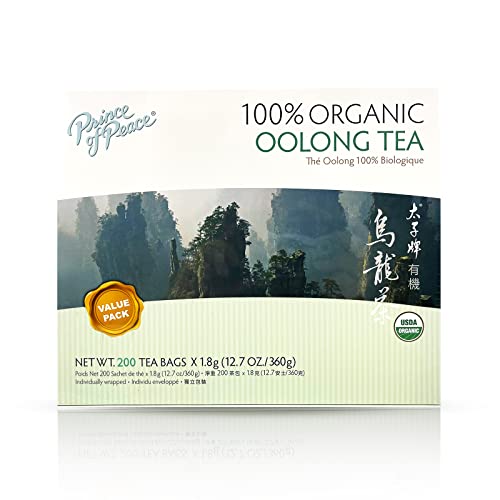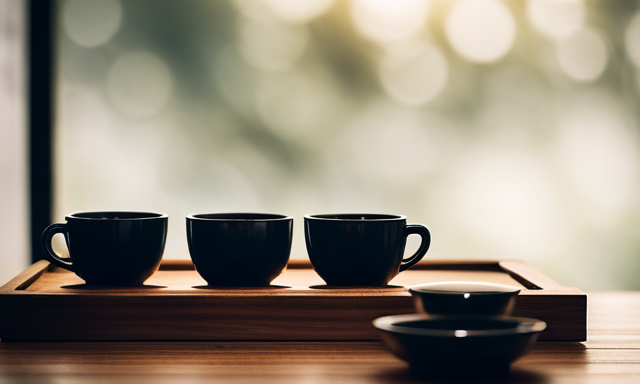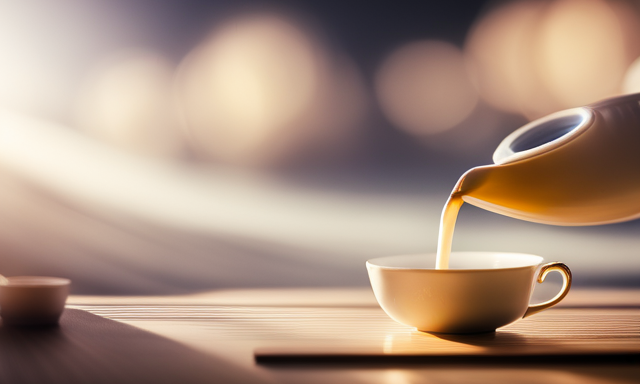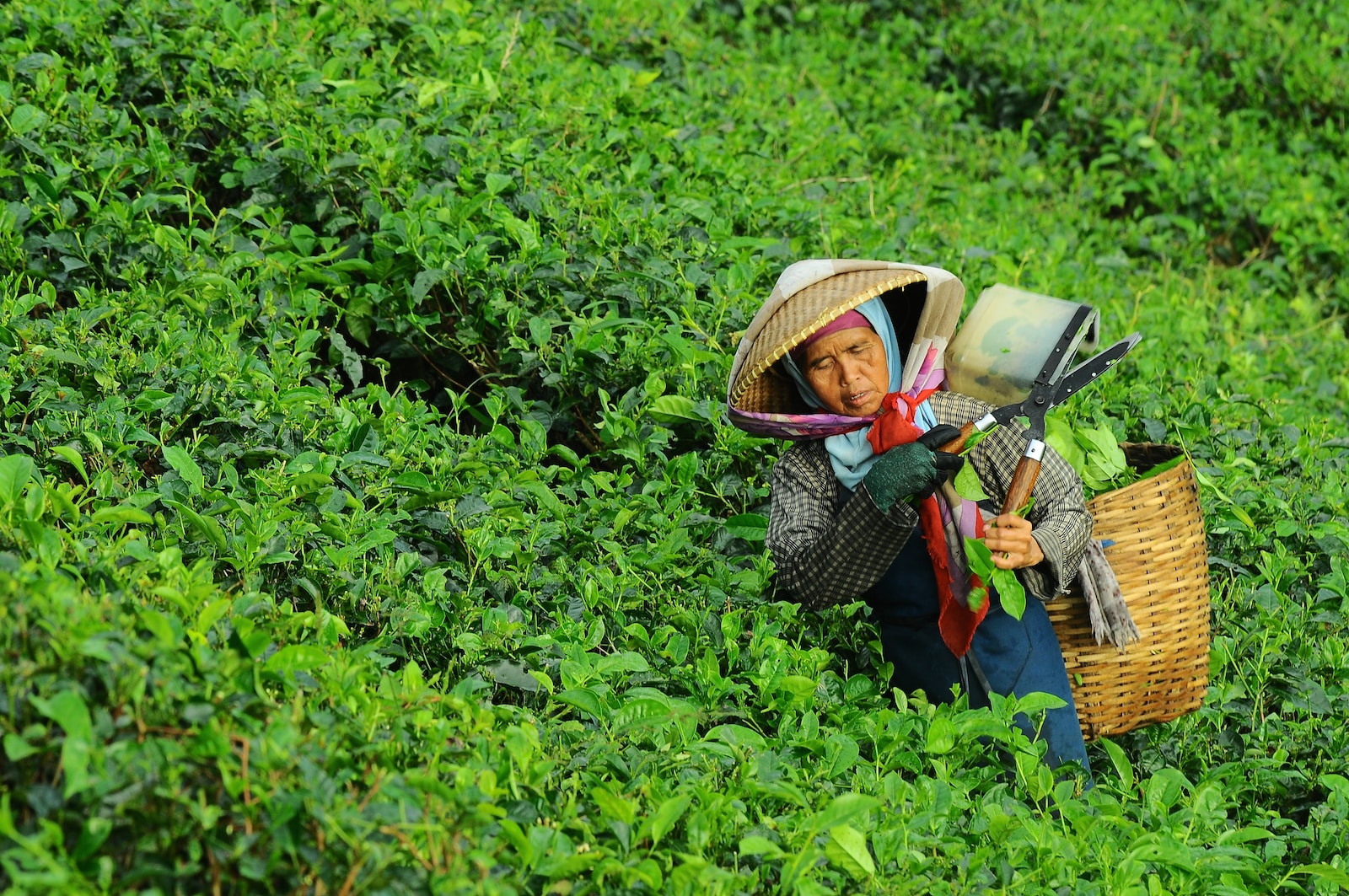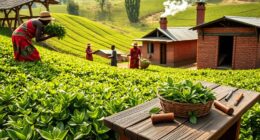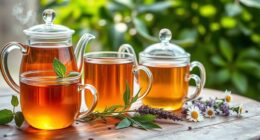Have you ever wondered what part of the tea tree plant is used to make oolong tea? Well, let me take you on a journey through the fascinating world of this beloved tea.
Oolong tea, known for its unique flavor and aroma, is made from the leaves of the Camellia sinensis plant. These leaves undergo a special process that sets oolong tea apart from other varieties.
Imagine a tea farmer carefully handpicking the tender, young leaves from the plant. These leaves are then skillfully processed using traditional techniques, including withering, rolling, and oxidizing. The level of oxidation is key to determining the flavor profile of oolong tea, ranging from light and floral to rich and toasty.
As you delve deeper into the article, you will discover the health benefits of oolong tea, brewing tips to enhance your tea experience, and an exploration of the various oolong tea varieties.
So, sit back, relax, and join me on this enlightening journey into the world of oolong tea.
Key Takeaways
- Oolong tea is made from the leaves of the Camellia sinensis plant.
- The leaves used for oolong tea are mature leaves and buds.
- Tea tree oil is not derived from the leaves used for oolong tea.
- Oolong tea combines the freshness of green tea with the richness of black tea.
Introduction to Oolong Tea
Oolong tea combines the freshness of green tea with the richness of black tea. It is a traditional Chinese tea that falls between green and black teas in terms of oxidation levels.
Oolong tea has a long and fascinating history that dates back over 400 years. Legend has it that oolong tea was discovered by a tea farmer who forgot about his tea leaves and they oxidized more than usual, resulting in a unique flavor. Since then, oolong tea has become highly prized for its complex taste and health benefits.
It is known for its floral and fruity flavors, as well as its smooth and mellow texture. Now, let’s explore the tea leaves used for oolong tea.
The Tea Leaves Used for Oolong Tea
The leaves that go into making this unique and flavorful tea are carefully selected and processed. Oolong tea is made from the Camellia sinensis plant, just like black and green tea. However, oolong tea is distinct in its taste and aroma due to the specific leaves used.
Oolong tea is made from mature leaves and buds, which are plucked from the tea tree. These leaves are then withered under the sun to reduce moisture content. After withering, the leaves are lightly oxidized, which gives oolong tea its characteristic flavor profile. The oxidation process is crucial in developing the complex flavors and aromas of oolong tea.
It is interesting to note that tea tree oil, known for its medicinal properties, is not derived from the leaves used for oolong tea. Instead, it is extracted from the leaves of a different plant species.
Now, let’s explore the fascinating harvesting methods for oolong tea.
Harvesting Methods for Oolong Tea
Imagine you’re standing in a lush tea garden, surrounded by skilled farmers who expertly pluck the most exquisite leaves and buds, like delicate treasures, to create the captivating oolong brew. Harvesting methods for oolong tea play a crucial role in ensuring the quality and taste of this beloved beverage. There are two primary methods employed: hand picking and machine harvesting. Hand picking involves carefully selecting the young leaves and buds by hand, ensuring only the finest and freshest ones are chosen. This meticulous process requires skilled hands and a deep understanding of the tea plant. On the other hand, machine harvesting involves the use of specialized equipment that mechanically harvests the leaves. While this method is more efficient, it may not achieve the same level of precision as hand picking. The chosen method greatly impacts the flavor profile and overall quality of the oolong tea produced. Transitioning into the subsequent section about ‘processing techniques for oolong tea,’ the harvested leaves undergo a series of intricate steps to bring out their unique characteristics.
Processing Techniques for Oolong Tea
Step into the world of oolong tea processing and discover the artistry behind crafting its distinctive flavors and aromas.
In the process of creating oolong tea, the fermentation process plays a significant role. After the leaves are harvested, they undergo a controlled fermentation process that brings out the unique characteristics of oolong tea. This fermentation process allows the tea leaves to develop complex flavors and aromas, giving oolong tea its rich and nuanced taste.
Another crucial aspect of oolong tea processing is the roasting technique. This step involves carefully roasting the fermented tea leaves to enhance their flavors and create a balanced and aromatic profile. Roasting helps to remove any residual moisture from the leaves and adds a subtle smokiness to the tea. It also helps to seal in the flavors and aromas, ensuring a delightful cup of oolong tea.
As we delve into the subsequent section about oxidation levels in oolong tea, we’ll explore how this process further contributes to the unique qualities of this beloved beverage.
Oxidation Levels in Oolong Tea
Explore the varying degrees of oxidation in oolong tea, allowing you to appreciate the intricate balance of flavors and aromas that each level brings to your cup.
-
Delicate oxidation: This light oxidation level preserves the tea’s fresh, floral notes, giving it a refreshing and subtle taste that dances on your palate.
-
Moderate oxidation: With a deeper oxidation level, oolong tea develops a richer flavor profile, showcasing notes of fruit, honey, and roasted nuts. The complexity of this tea keeps your taste buds engaged with each sip.
-
Heavy oxidation: This intense oxidation level produces a robust and bold oolong tea, characterized by deep, earthy flavors and a smooth finish. It offers a satisfying depth that lingers on your tongue, leaving you craving for more.
Understanding the oxidation levels in oolong tea sets the stage for exploring the unique flavor profiles that each step brings to your cup, creating a truly enriching tea experience.
Now, let’s delve into the fascinating world of oolong tea flavors.
Flavor Profiles of Oolong Tea
Get ready to embark on a tantalizing journey as your taste buds are transported to a world of enticing flavor profiles found in the captivating realm of oolong tea. Oolong tea offers a wide range of flavor profiles, making it a beloved choice among tea connoisseurs.
From floral and fruity notes to woody and nutty undertones, oolong tea has something to offer for every palate. The flavor profiles of oolong tea can vary depending on factors such as the oxidation level, growing region, and brewing techniques.
By adjusting the brewing time and water temperature, you can bring out different flavors and aromas in your oolong tea. Whether you prefer a light and delicate brew or a rich and robust infusion, oolong tea has the versatility to cater to your taste preferences.
As we explore the health benefits of oolong tea, you will discover how this exquisite beverage can nourish both your body and soul.
The Health Benefits of Oolong Tea
Indulge in the delightful and invigorating benefits of oolong tea as it tantalizes your taste buds and nourishes your body and soul. Here are four fascinating facts about oolong tea that’ll capture your attention:
-
The history of oolong tea dates back to ancient China, where it was enjoyed by emperors and scholars for its exquisite taste and health benefits.
-
Oolong tea falls between black and green tea in terms of caffeine content. It provides a gentle energy boost without the jitters often associated with coffee.
-
Oolong tea is rich in antioxidants that help combat free radicals and promote overall well-being.
-
Studies suggest that oolong tea may aid in weight management by boosting metabolism and reducing fat absorption.
Now, let’s delve into the art of brewing oolong tea and discover the secrets to making the perfect cup.
Brewing Tips for Oolong Tea
Now that we’ve explored the health benefits of oolong tea, let’s dive into some brewing tips to ensure you get the most out of your tea experience.
The brewing temperature for oolong tea is crucial, as it can greatly affect the flavor profile. Generally, oolong tea is best brewed at a temperature between 190-205°F (88-96°C). This allows the leaves to unfurl and release their unique flavors without scalding them.
As for steeping time, it varies depending on the type of oolong tea you have. Lighter oolong teas may require a shorter steeping time of around 2-3 minutes, while darker oolong teas can be steeped for 4-5 minutes. Remember to experiment and adjust the brewing parameters to suit your taste preferences.
By carefully controlling the temperature and steeping time, you can unlock the full potential of your oolong tea.
So, let’s move on to exploring different varieties of oolong tea.
Exploring Different Varieties of Oolong Tea
Take a journey through the diverse world of oolong tea and discover a multitude of flavors and aromas that will transport your taste buds to paradise.
When exploring different varieties of oolong tea, it’s fascinating to delve into the tea plantations where these exceptional teas are grown. Oolong tea is meticulously crafted through a complex production process that requires careful attention to detail.
From plucking the tender tea leaves to withering, rolling, and oxidizing, each step contributes to the unique characteristics of oolong tea. The level of oxidation can vary, resulting in a wide range of flavors, from light and floral to rich and robust.
By exploring the various tea plantations and understanding the oolong tea production process, you can truly appreciate the artistry and skill that goes into creating this extraordinary beverage.
Frequently Asked Questions
How long does it take for the tea leaves to oxidize during the processing of oolong tea?
During the processing of oolong tea, the tea leaves typically oxidize for around 60-75 minutes. Oolong tea is best brewed using loose tea leaves to allow for proper infusion and release of flavors. Using a regular tea bag may not provide the same quality and taste.
What are the different types of harvesting methods used for oolong tea production?
There are three common harvesting methods for oolong tea: hand plucking, machine harvesting, and combination harvesting. Hand plucking is the most common and labor-intensive method, ensuring the highest quality leaves. Oolong tea offers numerous health benefits, including improved digestion and heart health.
Can oolong tea be brewed using a regular tea bag or is it necessary to use loose tea leaves?
Oolong tea can be brewed using either a regular tea bag or loose tea leaves. While tea bags are more convenient, loose tea leaves offer a richer and more flavorful experience.
Are there any specific health benefits of oolong tea for weight loss?
Oolong tea has specific health benefits for weight loss. Its metabolism-boosting properties and ability to regulate blood sugar levels can aid in shedding pounds. Incorporating oolong tea into a balanced diet can support your weight loss journey.
Are there any specific brewing techniques or equipment that should be used for different varieties of oolong tea?
To properly brew different varieties of oolong tea, it is important to consider the specific brewing techniques and equipment used. These factors play a crucial role in achieving the perfect balance of flavors and extracting the tea’s unique characteristics.
Conclusion
In conclusion, oolong tea is a fascinating beverage that offers a multitude of flavors and health benefits. One interesting statistic that may surprise you is that oolong tea has been found to help boost metabolism and aid in weight loss. Studies have shown that regularly consuming oolong tea can increase fat burning by up to 10%.
This impressive statistic showcases the potential of oolong tea as a natural and effective tool for those looking to maintain a healthy weight. So why not indulge in a cup of oolong tea and experience its wonders for yourself?

